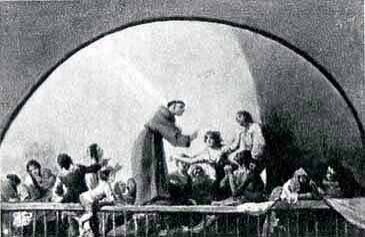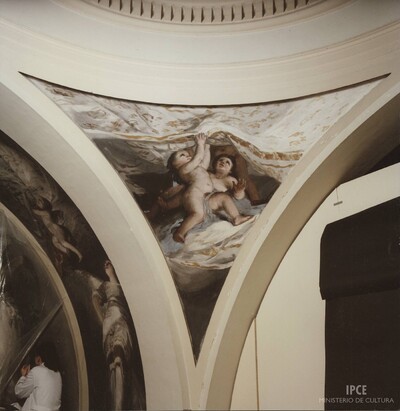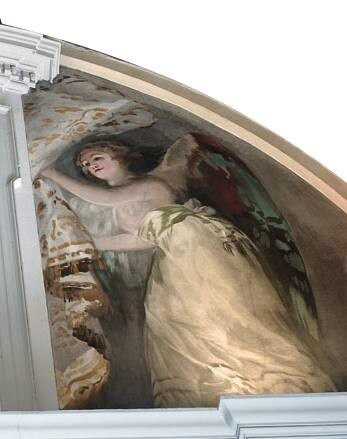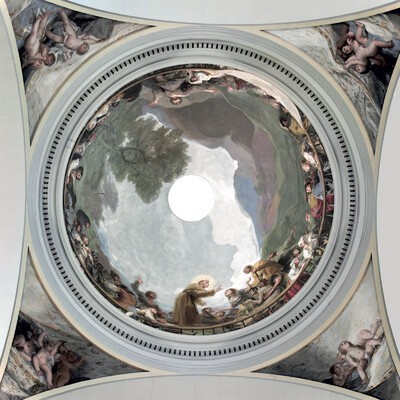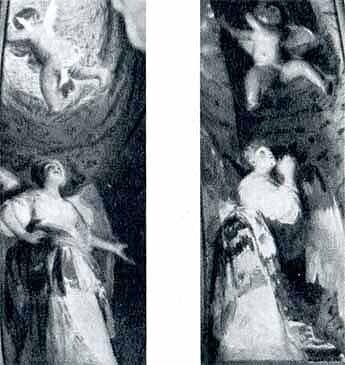- Cronología
- Ca. 1798 - 1800
- Ubicación
- Carnegie Museum of Art, Pittsburgh, United States
- Dimensiones
- 55.3 x 266 cm
- Técnica y soporte
- Oil on canvas
- Reconocimiento de la autoría de Goya
- Attributed work
- Titular
- Carnegie Museum of Art
- Ficha: realización/revisión
- 14 Oct 2010 / 13 Jun 2023
- Inventario
- (65.15)
This sketch was first brought to light by Enrique Lafuente Ferrari in 1961. At that time it was part of the private collection of Madame Chapert: it now belongs to the Carnegie Museum of Art in Pittsburgh.
The provenance of the sketch is uncertain, although Lafuente Ferrari believes that Goya took the piece to Bordeaux with him, since it seems to have belonged to a doctor in south-west France for many years, who inherited it from his ancestors.
This elongated sketch shows the whole set of figures depicted in the cupola of the Chapel of San Antonio de la Florida in the form of a frieze. The composition is similar to the final piece in terms of the distribution of the groups of figures, shapes and colours.
The canvas is divided into four sections which must have been painted separately and then sewn together.
Although it is quite similar to the original, there are differences in this sketch, such as in the balustrade which here has 71 banisters while in the final painting there are 81. The main group containing Saint Anthony is given more emphasis in the fresco, since the figures are grouped closer together and the saint's head is raised higher up above the other figures.
Other modifications were made that took the perspective from which the fresco would be viewed from below into account. Thus, the beads on the rosary carried by a blind man are shown as round in the sketch, whereas in the definitive work these become elongated marks. Likewise, some of the figures are distorted in the cupola painting: in the sketch they seem to be more refined and delicate, while in the fresco they are simpler and sketchier.
Gudiol firmly dismissed the idea that this could be the work of Goya, claiming that it is a later work. Since then, its authorship has been a subject of much contention. Buendía suggests that it could be the work of Eduardo Rosales. These doubts as to the authorship of the sketch are reflected in the vague, extended date range suggested for this work.
-
GoyaBasle2021pp. 120-122
-
Les fresques de San Antonio de la FloridaSkira1955
-
El boceto para la cúpula de San Antonio de la FloridaArte EspañolMadrid1961pp. 133-138
-
L’Esquisse qui servit à Goya pour San Antonio de la FloridaConnaissance des Arts1963pp.32-33
-
Vie et ouvre de Francisco de GoyaParísOffice du livre1970pp. 192, cat. 721
-
BarcelonaPolígrafa1970vol. I, pp. 303-304
-
Francisco de Goya, 4 vols.ZaragozaCaja de Ahorros de Zaragoza, Aragón y Rioja1980-1982vol. III, p. 103
-
La ermita de San Antonio de la FloridaAyuntamiento de Madrid1992p. 35


